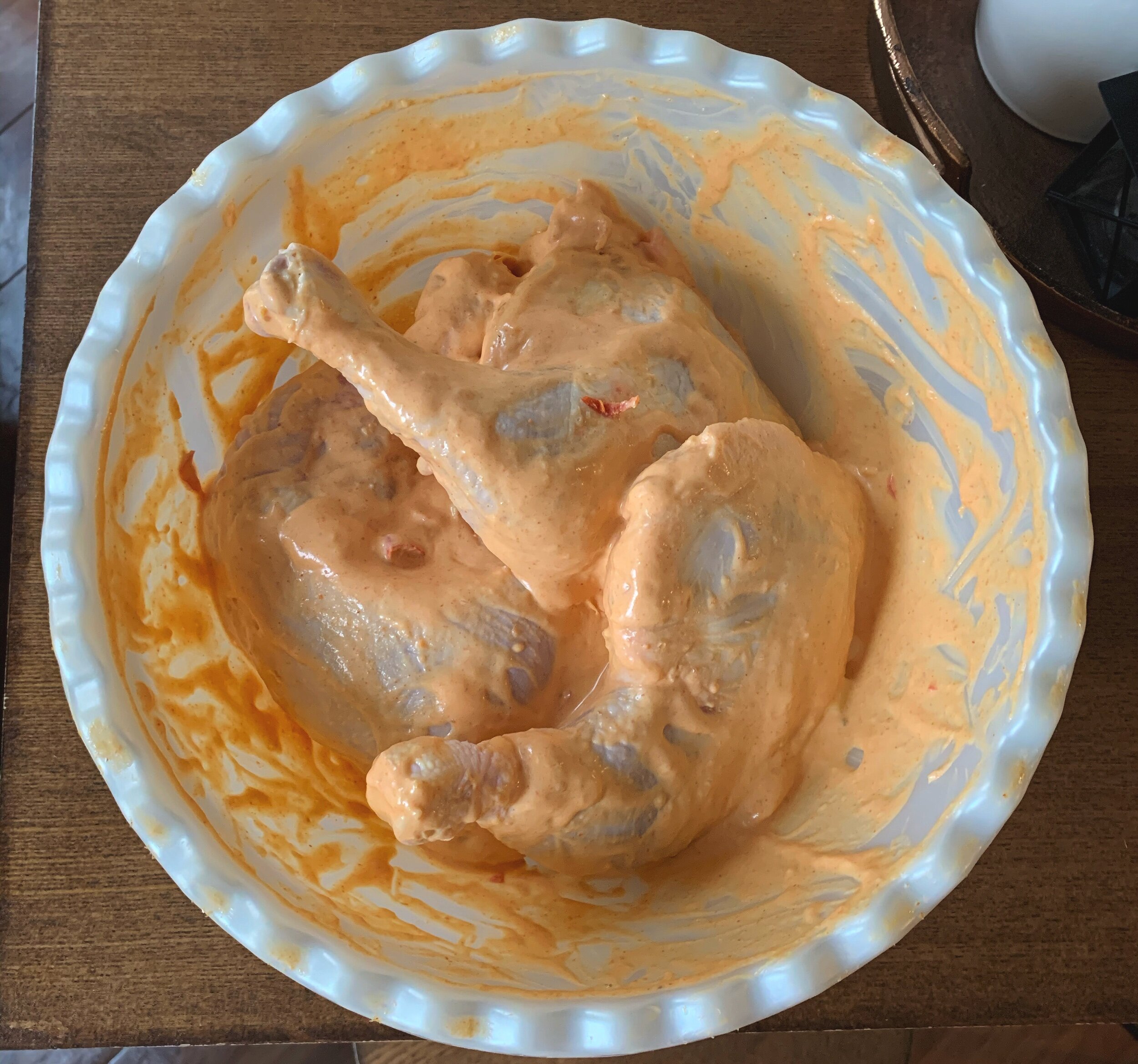Red Curry & Lemongrass Chicken
Yields: 4 servings
Time: Overnight prep, 45-60 minute cook
Lemongrass is a very popular ingredient in Thai cooking. It’s used as a way to bring a bright citrus note to any dish without the acidity of an actual citrus fruit. I play on other traditional Thai flavors in the marinade for this chicken. Coconut milk, Thai chilies, red curry and a secret ingredient make for a creamy, spicy, and tart sauce that is perfect to spoon over each serving of chicken and fluffy basmati rice.
Ingredients:
4 chicken quarters (leg and thighs attached)
13oz can unsweetened coconut milk
Tamarind paste (the secret ingredient!)
Thai chilies (seed for less heat)
Lemongrass
Thai red curry paste
Fish sauce
Lime
Ginger
Garlic
Kosher salt
Black pepper
Avocado oil
Scallions
Basmati rice
Special Equipment:
Cast iron or other oven-safe skillet
Microplane
Directions
Step One:
Season chicken quarters with kosher salt. Let sit 30 minutes.
Step Two:
In a mixing bowl, whisk together can of coconut milk, the juice of one lime, and two large spoonfuls each of tamarind paste and Thai red curry paste. Roughly chop 1 stalk of lemon grass and 2-3 Thai chilies, add to mixture. Using the microplane, grate 2-3 cloves of garlic and a 1.5-2 inch piece of ginger root into marinade. Add a few dashes of fish sauce and whisk until combined. Season to taste with kosher salt and black pepper.
Step Three:
Coat chicken with marinade in a large bowl or large plastic bag. Cover and refrigerate overnight or at least 3 hours.
Step Four:
Heat oven to 400º.
Bring chicken to room temperature for at least 1 hour before cooking. When chicken is at room temp, heat a few tablespoons of avocado oil in a cast iron skillet over high heat. Scrape as much marinade off the chicken as possible, reserving all excess marinade. Working two pieces at a time, place chicken in skillet skin side down and sear until golden brown, 4-5 minutes on each side. Repeat with remaining two pieces.
Step Five:
Remove chicken from pan and pour in all reserved marinade. Scrape pan with a wooden spoon and stir into marinade. Place all four pieces of chicken in skillet and place on the middle oven rack. Roast for 30-45 minutes or until the internal temperature reaches 160º-165º. Half way through roasting time, spoon some of the sauce over chicken quarters.
Step Six:
While chicken is roasting, prep garnishes and sides. Remove all seeds and finely chop one Thai chili (or keep whole for #aesthetic). Roughly chop two scallions, set both aside. Wash 2 cups of basmati rice by rinsing in cold water until the water runs clear.
In a sauce pan, bring 3 cups of water to a boil. Add in 2 cups of washed basmati rice and 2 tsp. of kosher salt. Stir to combine and reduce heat to low. Cover and cook for 15 minutes. After 15 minutes, remove from heat and let sit covered for 5 more minutes. Fluff with a fork when ready to serve. Season to taste with more salt if needed.
Step Seven:
Remove chicken from oven and spoon more sauce over each quarter. Let rest for 10-15 minutes.
Serve each chicken quarter over a mound of basmati rice, drizzle with more sauce from the pan (trust me, you want this sauce to absorb into your rice, it’s phenomenal). Sprinkle with chopped chilies and scallions and enjoy!
Tamarind 101
Tamarind, or Tamarindus indica, is a tree native to northern Africa and parts of Asia. It bears legume-like fruits that have a sweet but very tangy pulp. It’s flavor is reminiscent of lemon, apricot, and dates. The fruit is very popular in Mexican candies! You can find fresh or dried tamarind in most Asian and Latinx supermarkets.
If you can’t find the paste, you can make your own from the fresh or dried legumes! Remove fruit from outer pod and place in a stainless steel or enameled cast iron pot (the flesh is very reactive with aluminum, bare cast iron, and other metals). Combine 250 grams of flesh with 3 cups of boiling water. Let sit for 30 minutes then strain. Using a gloved hand, mill fruit through the strainer into same pot. Boil the strained flesh for 5 minutes, covered. Let cool completely. Store in the fridge for up to two weeks or in the freezer up to 6 months.





